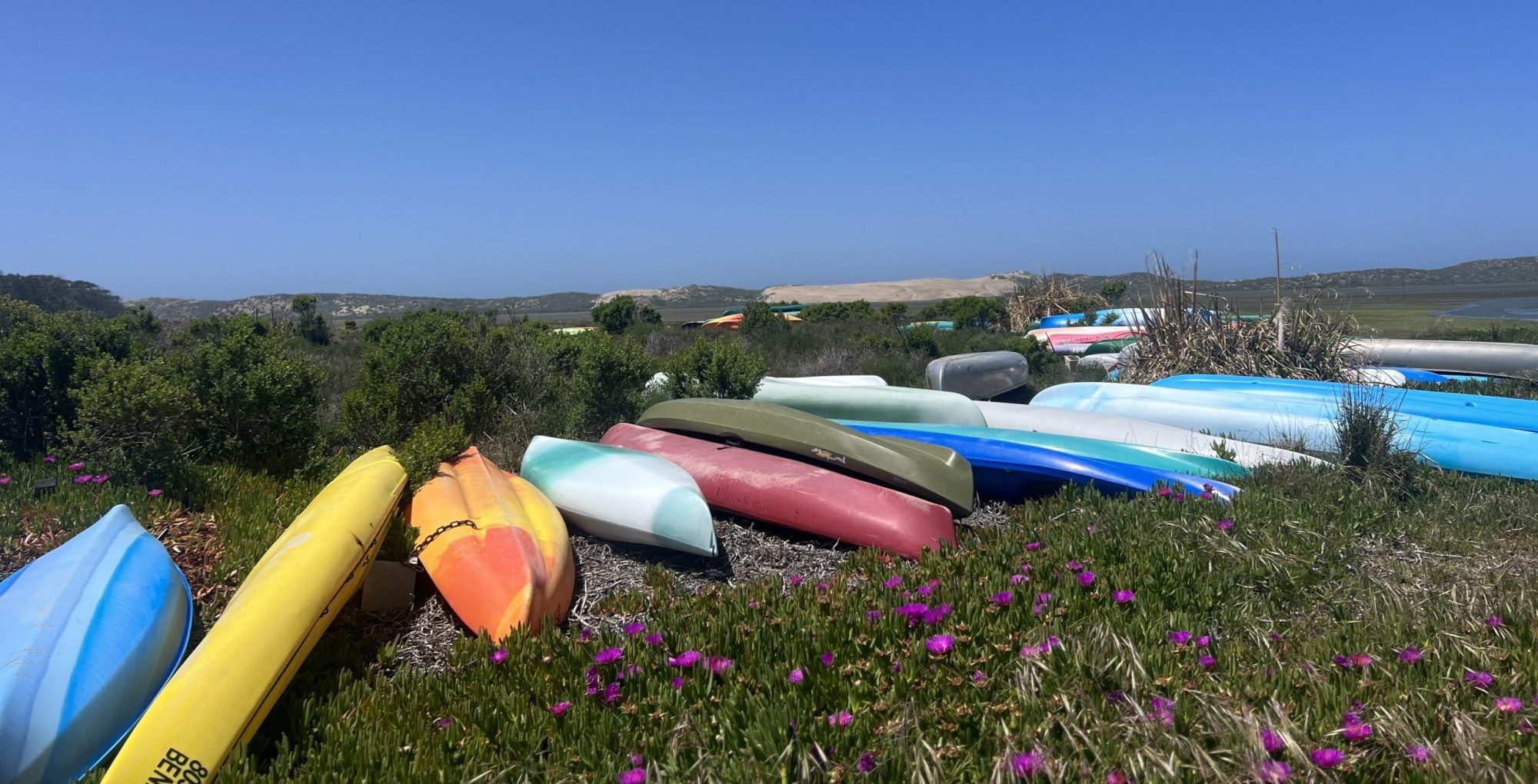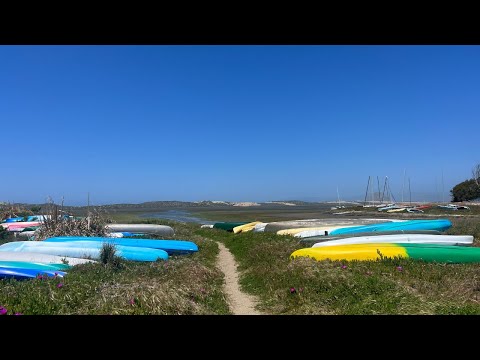It’s a quiet, foggy morning at Cuesta Inlet in Los Osos. Andrea Lueker, a retired local politician and ex-Cal Poly professor, is standing next to a heavily trodden path peeking through the grass next to the bay. Nearby, there are people launching kayaks and a sailboat. Lueker, who has resided in the area since the 1980s, recalls teaching her dog how to swim less than twenty feet from where she stands. Like many others, she comes here nearly every morning to enjoy the peaceful natural environment of the inlet. But in the background of the morning bustle of activities, a “for sale” sign looms.
Two years ago, Cuesta Inlet — a park with trails and ocean access widely used by the Los Osos community — went up for sale, threatening nearly 30 years of public use of the land.
“And that really stimulated the community to say, are you kidding me? Why is it for sale? Who owns it? What are we going to do? Because clearly, when you walk out here, you can see that people use it a lot.” Said Lueker, who now adds president of non-profit organization Save Cuesta Inlet to her lengthy list of community service.
Cuesta Inlet consists of 13 acres of land, some of which is partially underwater. It serves the Los Osos community as a place to walk nature trails and watch sunsets. It’s a gathering place for local birds and birdwatchers. The inlet is an ideal spot to launch small watercraft given its easy water access and hosts around 500 kayaks and canoes, as well as nearly 20 sailboats on its shores. There are signs posted around the inlet stating that it is a privately owned property that is open to the public, with simple requests to pick up trash and write names and phone numbers on kayaks left next to the water. It wasn’t until the “for sale” sign was posted that many people realized public access was threatened.
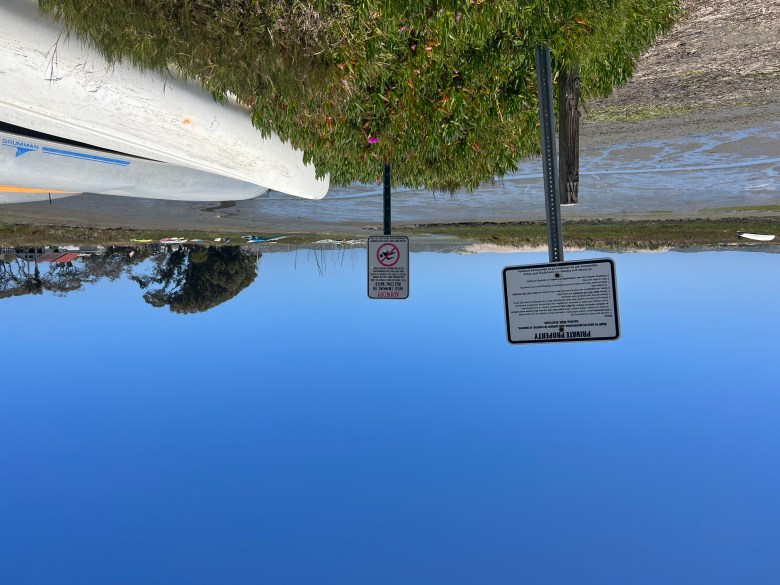
In response to this concern, a group of community members gathered to figure out how to ensure continued public access to Cuesta Inlet. As an outcome of these gatherings, the non-profit organization Save Cuesta Inlet was born to not just to keep the inlet in public hands, but also to support native wildlife and the community. The idea was to raise enough money to buy the land themselves and continue the tradition of public access. But it’s much more complicated than that.
The land — 1745 Doris Avenue — is listed for $1 million through Franklin Real Estate and Rentals. On their website, the property is described as “zoned recreational with potential for the development of shops, restaurants, fishing, bay tours, etc. The residentially zoned lots could have the potential for a nice home site.” A donor of Save Cuesta Inlet gave the group funds to have a conservation appraisal done on the property to evaluate the appraised value. In other words, to figure out exactly how much the property is worth. The appraisal, which spans nearly 300 pages and covers areas like environmental aspects and best use of the property, totaled $720,000.
What the group soon learned was that the California Department of Tax and Fee Administration states that nonprofits can only buy properties at their appraisal value and not a cent more, meaning that their original plan to purchase the inlet themselves was no longer possible. Government entities like the state of California and San Luis Obispo county are bound to the same rules and restrictions as non-profits when it comes to purchasing land, ruling out the possibility of their interference.
Lueker, among many others, worries that any person can come in and buy the land at the $1 million value.
“Somebody could buy it, and they could close it off,” Lueker said. “There’s [so much historical use that I think it could make it difficult] to close it off altogether to the public, but they could still make it really hard [to access]. And so that’s why we have to get started. What if somebody bought it, and we did nothing?”
While the group remains hopeful that the owners would consider dropping the price to the appraisal value so they could purchase the inlet, the likelihood of this possibility seems low. Jack Franklin represents the owners as their real estate broker and he said that at least three out of the five owners have other priorities.
“The owners believed that the property was worth $1.5 million, but they put it at $1 million thinking it would sell just like that. It didn’t—and those three owners dug in their heels. They just aren’t going to discount it anymore.”
For both parties, the sale to the non-profit would occur in an ideal world, but the owners would like to get their money’s worth, according to Franklin.
Like much of Los Osos, the inlet is under a water moratorium that was placed by the county, which prevents development. For a long time, those concerned about potential development of the inlet were soothed by the numerous challenges any developer would face trying to build on the land—the moratorium being one of them. This safety net shifted during May of 2024, after the Coastal Commission announced a potential plan to end the moratorium. This is big news in a town that has seen minimal new construction since the moratorium was put in place in 1988.
“The owners believe that the minute the moratorium is lifted, the value of the property could double,” Franklin said. “That is prime, waterfront property for just $1 million. You just can’t find that anywhere on the coast.”
As far as getting development approved, he also believes that the Coastal Commission “would look very favorably on anything that could serve the community, like a boat launch or fishing facility. They might even lead the charge on it.” Like everyone involved, Franklin has his own memories of the inlet. His children, who are in their 50s now, used to play there as children.
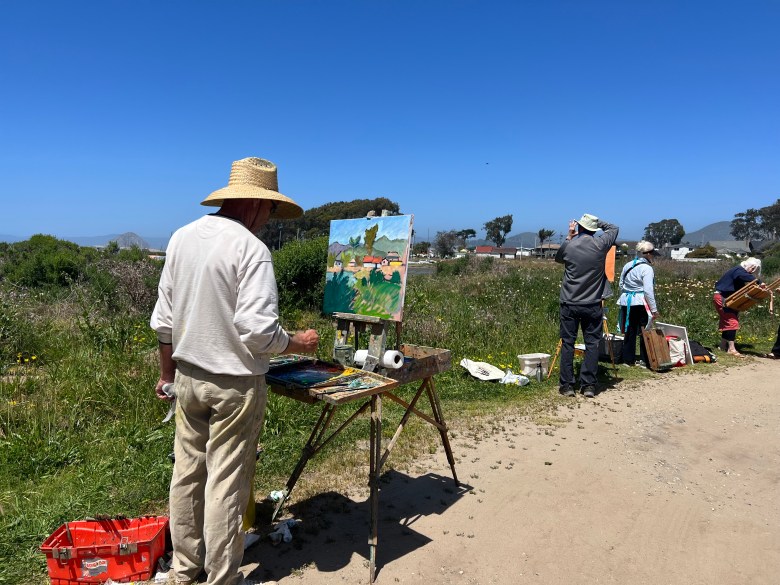
The land has had people attempting to develop it since the 1940s, but dreams of luxury homes with places to park your boat never came to fruition. The curves against the water and contours of the land are a result of bulldozer excavation. All original owners, who bought the property for $37,500 in 1992, are now deceased and the land has been passed down to their successors, the current owners. According to Franklin, the original owners didn’t intend to make the land publicly accessible. Ultimately, they allowed the community to use it with the understanding that they don’t abuse it.
“That’s the reason it’s being sold—because it is basically of no use to the current owners the way it is,” Franklin said.
Margarete Schmidt, a board member for Save Cuesta Inlet, admits that things are a bit rocky.
“Right now we’re in sort of a little bit of a stalemate here, in hopes that perhaps the people that have the inlet for sale might be willing to take a little less,” Schmidt said.
According to multiple sources at Save Cuesta Inlet, the owners could file a request to split the land into different parcels, so each could sell individually while not having to rely on the other owners to make decisions. If owners decide to sell their parcel at the appraisal value, then it gives Save Cuesta Inlet a chance to buy part of the land.
With all this focus on potential development, another key stakeholder tells a very different story. Bruce Gibson, the Second District County Supervisor for San Luis Obispo, said that current land regulations limit what can be approved and built on the inlet. Besides the unstable marshland and the potential for rising sea levels to infringe on the land, perhaps the biggest issue any developers face is Los Osos’ struggle for water. The community gets water from nearby aquifers, the top aquifer having been damaged from saltwater leaking into the freshwater from storms, among other environmental factors and pollutants. There is no outside water source connecting to the community, making access to water an issue when it comes to any new construction.
“How much development is going to be allowed given the water resource?” Gibson said. “That’s actually an active question right now, in conversations between the county and the Coastal Commission.”
In addition, if development were to occur, special steps would need to be taken to conserve the natural environment, as the regulations state. Gibson added that, “the land all through Los Osos is considered an environmentally sensitive habitat area. And so if you’re going to disturb the ground there, you have to do some offsetting mitigation.” If Gibson’s analysis is right, any development could be nearly impossible and the Save Cuesta Inlet offer of $720,000 may start looking more appealing.
If Save Cuesta Inlet is eventually able to purchase the land, the group has many ideas on what to do with it. Plans include replacing all invasive plants with native ones, creating more accessible paths for all abilities, adding picnic tables, and dealing with the excess of kayaks in the bay. Although the variety of many colorful kayaks make for a good picture, Schmidt said that many of these kayaks and boats are abandoned at the inlet—some having been there for decades. Since the land is privately owned, they are unable to move these boats or take any action on cleaning them up. Schmidt envisioned a kayak rack that might be more suitable to create more natural space and allow more plants to grow.
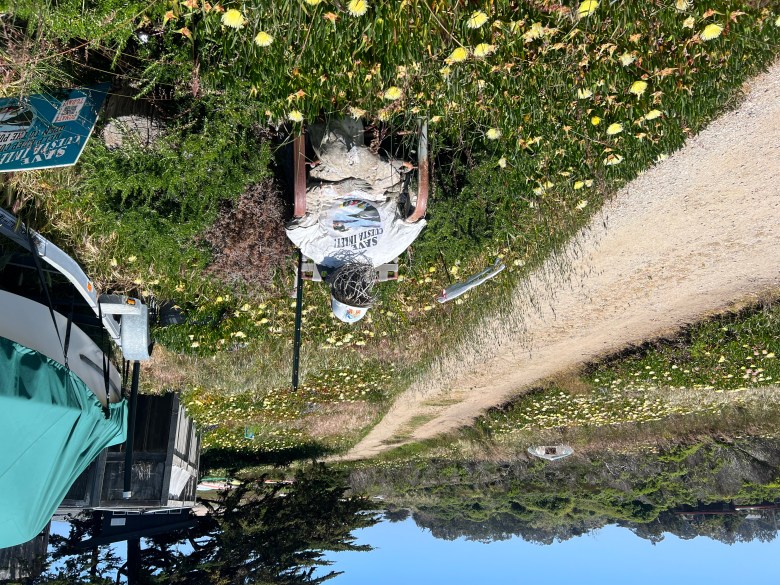
“They create a hazard as far as stifling plants and not allowing plants to grow. They’re also a home for things like rats, which is maybe a little bit of the wildlife we’re not too nuts about, and other animals here,” Schmidt said. “So our vision is something where we dramatically reduce the number of boats and probably have a designated area for storing kayaks for people who are actually using their kayaks.”
While Save Cuesta Inlet prepares for a future with the inlet in their hands, they recognize that they are playing a long, tough game. They are aware that there will be no overnight change, and welcome the challenge. Schmidt has heard a variety of opinions in regards to the non-profit, but none of them discouraging.
“I’ve yet to find anyone who has said ‘don’t do it’. I’ve found different people that have said ‘well, all the kayaks have to go’ and other people would say ‘well, the kayaks have to stay’… People have varying opinions on what should be done here. But everybody is very positive about it and really wants to see this go from private ownership into public ownership.”
Bruce Gibson, Second District County Supervisor for San Luis Obispo
Lueker recalls the many stories she’s heard of the inlet’s significance to the community.
“People come up to our group and say, my fiance proposed to me at Cuesta Inlet. Or we got married at Cuesta inlet. There’s all sorts of different stories, and the community is really passionate about it.”
It’s another misty day for Los Osos. Schmidt is standing next to one of the trails in the inlet, hair wind-whipped and gazing out at the open expanse of the bay. She comes here often, just like Lueker and hundreds of other community members. As always, there are kayaks being slipped into the water before disappearing into the fog, and walkers trailing after their dogs romping on the paths. Schmidt is contemplating the future of the land that surrounds her, but remains hopeful that their goal will prevail.
“One of our members said it best. Peace, love, and public access.”

